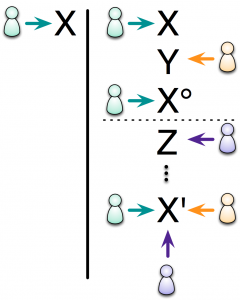In preparation for our webinar with Citrix and the eLearning Guild, I’ve been thinking through the benefits of learning socially, specifically for formal learning. I’ve articulated before that I think it’s about processing, but I like to try to capture my thinking in a graphic, and hadn’t done so before. I did so now, and thought I’d share it.
 In this representation, an individual, in creating an output such as a blogpost or a response to a discussion question in a forum, or a response to an assignment, has to do some reasonably robust processing. Typically, by going from thought to an external representation, you find that you’ve got some gaps and have to fix them. Eventually, however, you come up with what you think is right. And you submit it, say, in formal learning, and eventually may get feedback from an instructor.
In this representation, an individual, in creating an output such as a blogpost or a response to a discussion question in a forum, or a response to an assignment, has to do some reasonably robust processing. Typically, by going from thought to an external representation, you find that you’ve got some gaps and have to fix them. Eventually, however, you come up with what you think is right. And you submit it, say, in formal learning, and eventually may get feedback from an instructor.
But consider where you share that representation, and someone else comments in a way that indicates a different perspective, say in the discussion forum or to your post; then you may have to rethink what you said in light of that alternate viewpoint. You have to do some additional processing.
Then go further: suppose that a team has to come with a convergent answer. Then you might get a number of cycles of expressed viewpoints, additional processing (by all members of the team), sufficient to come to an agreed-upon view. Then you have lots of alternate ideas, and re-processing going on. That, to me, is the power of social learning. In that process of negotiation, you are thinking again and again about a topic, let alone with additional input and viewpoints.
Now, there are lots of nuances that have to go into this, such as designing an assignment that has enough ambiguity or challenge to have sufficient variety in viewpoint, but not so much as to lead to an inability to eventually agree.
This, of course, also is what happens in informal learning, if we end up discussing a problem to solve, or even just blog our thoughts and get comments. As Jay Cross says, the most powerful learning technology is conversation. It’s even better, however, if there’s a resulting artifact, a representation that captures the understanding, as the externality reduces the opportunity for misinterpretation.
So, does this representation make sense to you?
Hi Clarke,
Although they say a picture paints a 1000 words, for me personally on this occasion the diagram only served to confuse me. I found your text based narrative to more easily understood.
Great post by the way and one that indeed proved the point as I went through the process you described before replying…. hmmm… makes me wonder if it was intentional….?
Craig
Hi Clark,
I agree that the additional communication processing which we have to do when incorporating the viewpoints of others in a team and the iterations of that process in other team members to arrive at X’ is a truly great aspect of social learning, particularly in the digital realm where the viewpoints of others can be far more numerous and specialized.
In addition to the re-processing of ideas and communications, the process of rethinking our contributions when considering the viewpoints of others moves us outside of ourselves to appreciate the perspectives of others, which makes us grow as individuals.
Regarding the graphic, it represents the process well. I would use additional notation to represent the end-result, which tends to be an amalgamation of the most salient viewpoints from the group (depending on how outwardly democratic the group is!) plus a ranking system to confirm the significance of each sub-clause in the minds of the team, so instead of merely X’ I would have:
X’ + K’ + Z’ where X’ > K’ > Z’
Hi Clarke,
Thanks for this great post.
However, as mentioned by Craig, I have to confess that When I saw the diagram first, I didn’t figured out your thoughts; but after reading the entire post, it clearly make sense !
I agreed with the fact that social interaction between people lets move forward by rethinking our initial thoughts about a topic in different perspectives. This is what I call “contineous improvement” which is probably the most efficient learning way.
Ko
Thanks for all the feedback (it’s how I learn :). On several fronts it’s clear that the diagram is not self-explanatory. That may not be a bad thing (as Craig hints, but that was not my conscious intention, so I get no credit). Still, it’d help if it were more obvious; back to the drawing board.
As C A points out, I did wonder whether X’ was the ‘right’ final position to end up on, but I thought there might be some benefit to continuity. Maybe I’ll make a combined character or something.
Thanks again to all for the feedback. Keep on learning!
I wonder if it would be clearer if you used a network (hub spoke) where the hub was the originator of the issue and the tentative “answer” and the spokes were the iterations of the community members with their unique domain understanding and experiences. The answer would be tranformed/updated as it passes around the network and be updated and shown as close to the hub.